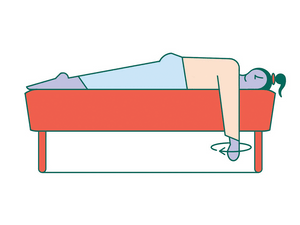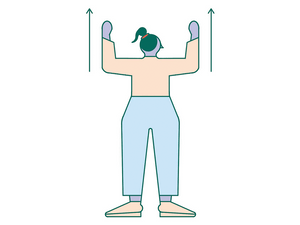How to Unfreeze Painful Frozen Shoulder

Frozen shoulder is a common and painful condition. Luckily, there are easy stretches that you can try to ease your pain.
Adhesive capsulitis, better known as frozen shoulder, is an uncomfortable condition characterized by pain in the shoulder joints and restricted range of motion. “I like to describe it as bubble gum in your shoulder, and you’re trying to move but it takes so much effort to move past a certain point,” says Surabhi Veitch, a Toronto-based physiotherapist and owner of the Passionate Physio. This condition makes everyday tasks like scratching your back or grabbing something off an overhead shelf feel impossible.
Like the name implies, frozen shoulder comes with an unbearable “stuck” sensation. The bones, ligaments and tendons that make up the shoulder joint are encased in connective tissue—frozen shoulder occurs when the connective tissue thickens and tightens around the joint, restricting movement. Often, people develop frozen shoulder because they’re not moving the joint frequently, such as when they’re in recovery from a surgery or injury, though a sedentary lifestyle can also cause the painful condition. People aged 40 to 60, and particularly post-menopausal women (thanks to a change in hormone levels), are the most likely to develop frozen shoulder.
Treatment for frozen shoulder typically focuses on pain management, and doctors will often suggest anti-inflammatory medications like aspirin or ibuprofen. In addition, easing frozen shoulder pain requires stretching out the connective tissue and restoring the joint’s range of motion. Getting into the habit of stretching can also fight off other aches and pains and help improve flexibility. According to Veitch, a stretching routine in the middle of your workday, especially if you’re sitting at a desk, can help maintain good range of motion and prevent injury.
One of the best exercises to integrate into your daily routine is called the lying pendulum. “With frozen shoulder, your muscles will be stiff. This stretch can help you regain movement in the shoulder,” says Ivana Sy, a Vancouver-based kinesiologist. Sy says to start by lying face down on a bed or coach. Then, drape one arm over the edge and let it dangle. Then, slowly move the affected arm side to side and forward and backward and around in circles. Repeat three times daily. Do the exercise for 30 seconds and, over time, increase the duration up to five minutes as you progress. According to Sy, the pendulum can really help improve range of motion and reduce aches and pains.
Veitch suggests using a wall to help stretch your shoulders. Start by facing a wall with your toes as close as possible to the baseboard. Then, place your hands at eye level and slowly creep them up the wall to create a stretch in your shoulder blades. Try to reach as high as you can!
Regaining or maintaining the ability to reach behind you is also important. As we age and lose mobility, Veitch notes that reaching back often becomes a challenge, even without a condition like frozen shoulder. “Many people are struggling to put on their bras, and they flip it around to do their bra up in the front,” says Veitch. “But if we avoid the movement, it becomes more difficult.” Practise reaching behind your back by grabbing one end of a scarf (or any length of fabric) with one hand. Holding the scarf on one end, reach over your shoulder, as if to scratch the back of your neck, to dangle the scarf down your back. With your other hand, reach back as if you were going to grab something from your back pocket. Instead, grab onto the opposite end of the scarf. With your top hand, pull the scarf to gently slide your bottom hand up. Switch hands and repeat.
“With true frozen shoulder, it can take a long time, even with treatment, to feel better,” says Veitch. “But the goal with stretches is to maintain mobility so your entire life is easier.”
(Related: 4 Stretches to Improve Range of Motion as You Age)
Try these frozen shoulder exercises:

The pendulum
Lying face down on a bed or couch, let one arm hang off the edge and move it back and forth and side to side to increase range of motion. Repeat on the other side.

Wall slides
Facing a wall with your feet as close to the baseboard as possible, place your hands on the wall at eye level and slowly inch your fingers up. Try to reach as high as you can!

Reach around
Grab a scarf end with one hand and reach up and over your shoulder, with it dangling down behind you. With the other hand, reach back and grab the bottom of the scarf. With the hand on top, slowly pull on the scarf to get your bottom arm to move up. Switch hands and repeat.




